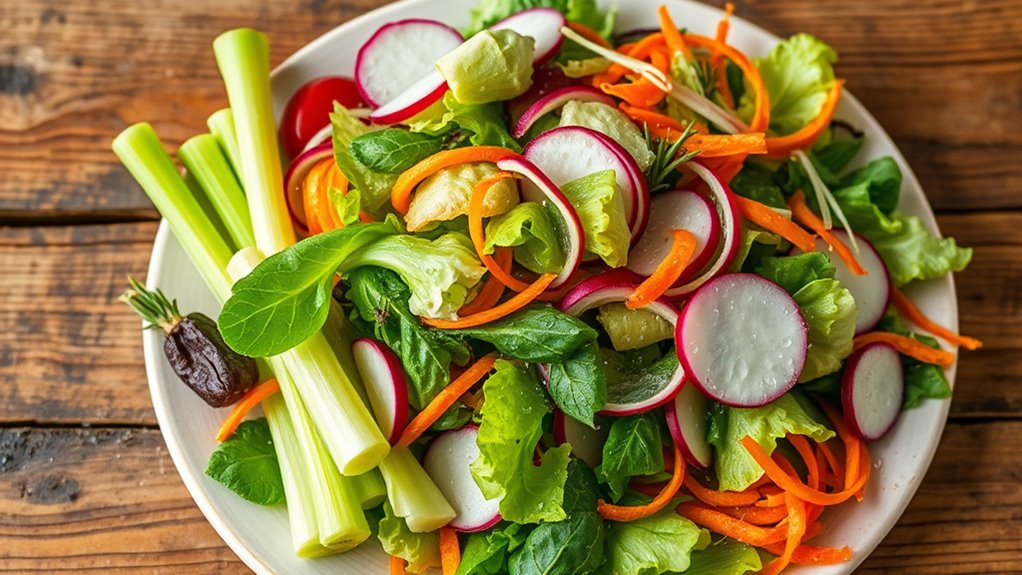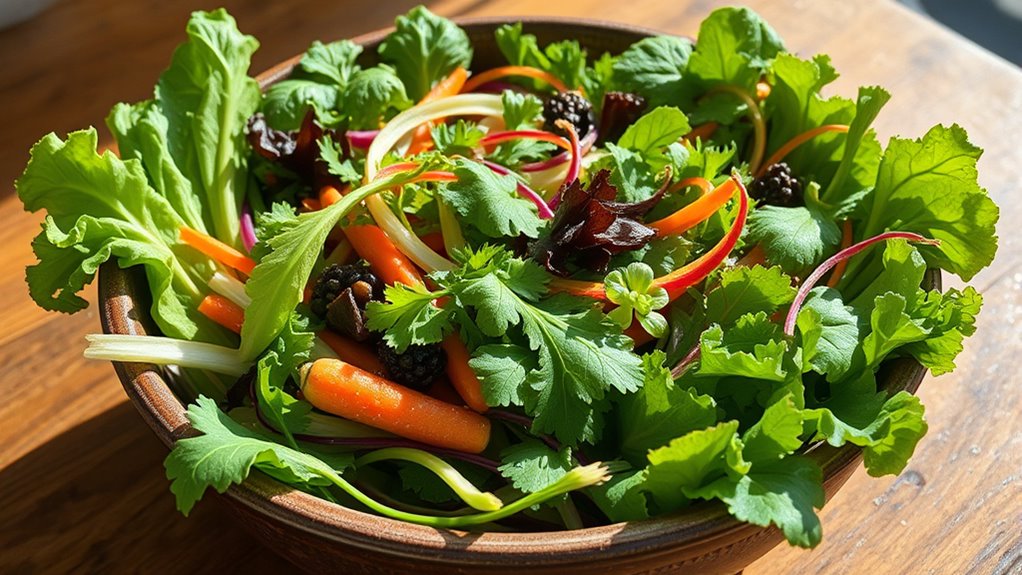To create zero-waste salads, use vegetable stems, leaves, and scraps instead of discarding them. Incorporate carrot tops, broccoli stems, beet greens, and other edible parts to add flavor and nutrients. Compost any leftover scraps to nourish your garden or freeze them for future stocks. By using the whole vegetable and focusing on seasonal ingredients, you’ll minimize waste and support sustainability. Keep exploring to discover more ways to turn scraps into delicious, eco-friendly meals.
Key Takeaways
- Incorporate edible stems and leaves, like carrot tops and broccoli stems, into salads to maximize vegetable use and reduce waste.
- Use vegetable scraps such as peels and cores in homemade dressings or as crunchy toppings to minimize discard.
- Compost vegetable scraps when not edible, turning waste into nutrient-rich soil and supporting sustainable gardening.
- Choose seasonal produce to ensure freshness and minimize packaging, promoting eco-friendly and zero-waste salad ingredients.
- Dry or freeze vegetable scraps for future use in stocks or broths, extending their utility and reducing overall waste.

Reducing waste in your daily meals is easier than you might think, especially when it comes to salads. Instead of tossing out vegetable stems, leaves, and scraps, you can incorporate them into your meal prep or compost them to benefit your garden and reduce landfill waste. Composting benefits are significant: it transforms organic waste into nutrient-rich soil, which supports healthy plant growth and reduces the need for chemical fertilizers. When you focus on seasonal produce, you get the freshest, most flavorful ingredients, and you minimize the environmental impact associated with long-distance food transportation. Plus, seasonal produce often comes with fewer packaging materials, making it easier to keep your waste minimal.
Reduce waste by using vegetable stems and scraps in salads and composting for healthier soil and a greener planet.
Using stems and leaves in your salads is a smart way to cut waste and enjoy more of your vegetables. For example, carrot tops, broccoli stems, and beet greens are all edible and packed with nutrients. Instead of discarding these parts, wash them thoroughly and incorporate them into your salads or smoothies. Not only do you reduce waste, but you also add variety and flavor to your meals. If you find yourself with vegetable scraps beyond what you can eat immediately, consider drying or freezing them for later use in stocks or broths, further maximizing their utility. Additionally, practicing efficient general ledger coding can help you track your waste reduction efforts and expenses more effectively, supporting your sustainability goals.
Scraps like peels, cores, and stems can also be composted instead of being thrown away. You’ll want to set up a dedicated compost bin or pile in your yard, where these scraps will decompose naturally. This process is straightforward and offers the benefit of returning nutrients to the soil, which encourages healthy plant growth. When you compost your kitchen waste, you’re closing the loop—reducing landfill contributions, lowering greenhouse gas emissions, and creating a valuable resource for your garden. Remember to balance your compost with browns (like dried leaves or paper) and greens (vegetable scraps and coffee grounds) to maintain an efficient composting system.
Focusing on seasonal produce makes it easier to practice zero-waste salad habits because these ingredients are usually more abundant and affordable. When you buy seasonal vegetables, you’re also supporting local farmers and reducing your carbon footprint. Use the entire plant when possible—stems, leaves, and scraps—rather than just the parts you’re used to eating. This approach not only minimizes waste but also enhances the sustainability of your eating habits. With a little planning, you can turn what might seem like waste into valuable ingredients or compost, helping you live more eco-consciously without sacrificing flavor or nutrition.
Frequently Asked Questions
How Long Do Leftover Salad Scraps Stay Fresh?
Leftover salad scraps typically stay fresh for 1-3 days when stored properly. To maximize freshness, use proper refrigeration techniques like airtight containers and keep the scraps dry. Check for spoilage indicators such as sliminess, off smell, or discoloration before consuming. If you notice any of these signs, it’s best to discard the scraps to avoid foodborne illnesses. Proper storage helps reduce waste and keeps your salads tasty longer.
Are All Vegetable Stems Safe to Eat?
They say “trust but verify,” and that’s true for vegetable stems. Not all stems are safe to eat—some, like celery, asparagus, and broccoli, are edible and nutritious. Edible stem varieties often have tender, flavorful textures, but always use stem preparation tips like peeling or trimming tough parts. Avoid stems from plants that aren’t meant for consumption, and when in doubt, research or ask an expert to stay safe.
Can I Compost Salad Scraps to Reduce Waste?
Yes, you can compost salad scraps to reduce waste. Composting benefits include enriching your soil and cutting down landfill waste. You can compost a variety of salad scraps like lettuce leaves, carrot tops, and cucumber peels. Just make sure to balance greens and browns, avoid meat or dairy, and turn your compost regularly. This way, your salad scrap variety transforms into nutrient-rich compost, supporting healthy plants and a greener lifestyle.
What Are Creative Ways to Reuse Salad Scraps?
Did you know that Americans waste about 150,000 tons of produce daily? You can get creative by turning salad scraps into kitchen crafts like homemade veggie broths or pickles, reducing waste and enhancing flavor. Use stems and leaves for flavor enhancement in soups or stews, or craft decorative garnishes. These ideas not only minimize waste but also add a fresh twist to your meals, making cooking more sustainable and fun.
How Do I Store Stems and Leaves to Prevent Spoilage?
To prevent spoilage, store stems and leaves in airtight storage containers in your refrigerator. Use crisper drawers, which maintain ideal humidity, to keep greens fresh longer. Wrap delicate leaves in a damp paper towel before placing them in the container for extra moisture control. Make sure to refrigerate promptly after washing, and avoid overcrowding, so air circulates. Regularly check and remove any spoiled parts to extend freshness.
Conclusion
By using stems, leaves, and scraps, you’re not just creating delicious salads—you’re helping the planet. Embrace the zero-waste mindset and turn leftovers into vibrant, nutritious meals. Remember, “Waste not, want not”—every bit counts in reducing your environmental impact. So next time you prepare a salad, get creative with those scraps. Little actions add up, making a big difference for a healthier Earth and a more sustainable future.









